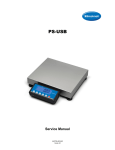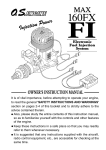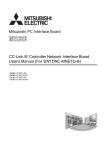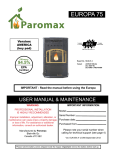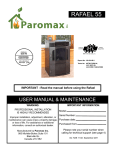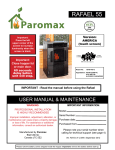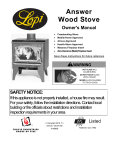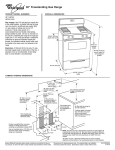Download metro legacy series ii service manual
Transcript
® METRO LEGACY SERIES II SERVICE MANUAL Diagnosis Charts Service Procedures Component Data Model 3530 30” Legacy Model 3535 30” Metro Model 3630 36” Legacy Model 3635 36” Metro Heartland Appliances Inc. Manual No. MLSM2003-09-03 0910-1 We have used all possible care to ensure the accuracy of the information contained in this book. However, Heartland assumes no liability for any errors, omissions or any defects whatsoever in the diagrams and/or repair procedures or for any damage or injury resulting from utilization of said diagrams and/or repair procedures. Safety Information: Electric and Gas Ranges are complex electromechanical devices. Any attempt to repair a range may, if improperly performed, result in personal injury or property damage. Heartland Appliances cannot be responsible for the interpretation of this manual, nor can it assume any liability in connection with its use. For additional safety information, see page 5 of this manual. Repair Manual for Heartland Appliances Inc Metro & Legacy Ranges 2003, September 3 Heartland Appliances Inc. 1050 Fountain St. N Cambridge, Ontario; N3H 4R7 All rights reserved. No part of this book may be reproduced in any form or by any means without written permission from Heartland Part# 0910-1 2 MLSM2003-09-03 Contents Section 1: Safety Information ............................4 Section 2: Parts and Warranty ..........................5 Section 3: Technical Specifications ....................7 Section 4: Problem Diagnosis Chart ..................8 Please Refer to Main Service Manual MLSM010601. Amendment is intended to illustrate changes made to the location of the relay board and the new clock. Section 5: Repair Procedures ........................... 9 A - Terminal Block 9 B - Timer Replacement 10 C - Timer Programming 11 D - Broil Element 12 E - Self Clean Latch Mechanism 13 F - Timer Relay Board 14 G - Timer Coaxial Cable 15 H - Cooling Fan & Thermodisk 16 I - Spark Module 17 J - Regulator Replacement 18 K - Gas Conversion 19 L - Burner Caps 21 M - Electrodes 22 N - Burner Valves 23 O - Back Panel Access 24 P - Stove Top Prop Up 25 Section 6: Wiring Diagrams .............................26 Models 3530/3535 26 Models 3630/3635 27 Section 7: Exploded Views and Parts List ........28 NOTE: FOR FULL SERVICE NOTES, PLEASE REFER TO SERVICE MANUAL #0910 3 MLSM2003-09-03 Section 1 Safety Information Important Safety Notice Heartland Appliances’ Service Manuals are intended for use by individuals possessing electrical, gas and mechanical experience. Therefore, Heartland Appliances cannot be responsible for the interpretation of its Service Manuals by those not having a background of electrical, gas and mechanical experience, nor can it assume any liability in connection with their use. During any such check, ensure no other conductive parts, panels or yourself come into contact with any exposed current carrying parts. 3. If a replacement part is required ensure it meets factory specifications. 4. Never by-pass or interfere with the proper operation of any feature, part or device engineered into the product. 5. Prior to reconnecting electrical power service to the product, ensure that: Safe Servicing Practices To preclude the possibility of resultant personal injury and/or property damage, it is imperative that safe servicing practices be observed. The following are examples, but without limitation, of such safe practices: 1. Before servicing, always disconnect the product from its source of electrical power by removing the product’s electrical plug from the wall receptacle or tripping the circuit breaker to OFF(or removing the fuse) in the branch circuit servicing the product. Note: If a specific diagnostic check requires electrical power to be applied such as for voltage or amperage measurements, reconnect electrical power only for time required for specific check, and disconnect power immediately thereafter. a) all electrical connections within the product are correctly and securely connected, b) all electrical harness leads are properly dressed and secured away from sharp edges, high temperature components (heaters, etc.) and moving parts, c) any un-insulated current-carrying metal parts are secured and spaced adequately from all non-currentcarrying metal parts, d) all electrical grounds (internal 4 and external to the product) are correctly and securely connected, and e) all access panels and covers are properly and securely assembled following the servicing and prior to operating the product. 6. On gas appliances, do not disturb gas-carrying components or connections until gas service to it is shut off, and do not use a flame to test for gas leaks. Following repair work, ensure all gas connections are properly secured by testing for gas leaks with a bubble (soap) solution. 7. Do not attempt a repair if you have any doubts as to your ability to complete it in a safe and satisfactory manner. MLSM2003-09-03 Section 2 Parts & Warranty How To Obtain Parts: How To Set Up Warranty Service: • • • Contact an authorized Heartland dealer or Heartland Appliances direct. When ordering replacement parts (warranty or not) always provide the following information: Serial Number Model Number Component Description Part number • • Commonly replaced parts are listed in Section 7 at the end of this book and at the back of the owner’s manual. To obtain replacement parts directly from Heartland, contact the following departments: Heartland Appliances Inc. 1050 Fountain St. N. Cambridge, Ontario N3H 4R7 ph: 877-650-5775 fx: 800-327-5609 Warranty & Non-Warranty Replacement Parts: Service Dept. Ext. 2241 & 2264 Note: Please contact Heartland Appliances Service Department prior to performing service work in order to assist in the diagnosis of the problem, this should result in having to go to the customer’s home only once. Contact one of the manufacturer’s service technicians to obtain a CSF reference number. CSF number will serve as authorization to proceed with warranty work and will be referenced for any future warranty work. Contact Heartland Appliances Service Department at: Heartland Appliances Inc. 1050 Fountain St. N. Cambridge, Ontario N3H 4R7 ph: 877-650-5775 fx: 800-327-5609 Service Department: Extensions 2241 & 2264 • • Warranty Claim forms to include, but not limited to, the following information: • Customer Name, Address and Phone Number Serial Number Model Number Date of Service Work Performed Full Description of Work Performed CSF Reference number (see “How To Set Up Warranty Service” section above for details). • • • • • • How to Return Merchandise: • CSF number to be referenced in all warranty claims Contacting Heartland Appliances prior to performing service work, will assist in the diagnosis of the problem, this should result in having to go to the customer’s home only once. How To Submit Warranty Claims: • • For prompt warranty claim processing, submit your standard service form (i.e. Narda style) completely filled out to: Heartland Appliances Inc. Service Department 1050 Fountain St. N. Cambridge, Ontario N3H 4R7 fx: 800-327-5609 5 Contact Heartland Appliances’ Service Department to obtain authorization for any merchandise returns at: Heartland Appliances Inc. 1050 Fountain St. N. Cambridge, Ontario; N3H 4R7 ph: 877-650-5775 fx: 800-327-5609 Service Department: Extensions 2241 & 2264 • Depending on the nature of the merchandise to be returned, an RGA number (Return Goods Authorization) may be issued. A comprehensive RGA Kit package will be expedited with instructions and back up paperwork for the prompt and safe return of the goods. MLSM2003-09-03 Section 2 Parts & Warranty Serial Number Location in Ranges: • Metro & Legacy ranges have the serial number located at the back of the range and on the kick plate. To view serial number plate, open door, and look at kickplate’s right top corner. (view shown with door removed) 6 MLSM2003-09-03 Section 3 Technical Specifications Dual Fuel Ranges (Electric Oven & Gas Top) • 30” Models 3530/3535 240V, 60Hz, 4.1 Kw (3 prong or 4 prong) Bake Element: 3400 W Broil Ribbon Element: 4000 W Conv. ring element: 2400 W Natural Gas (6” w.c.) Propane (11” w.c.) ½” NPT (5/8” flex line) Surface Burners (4):15,500 Btu Note: Service Amperage to be calculated by a qualified electrician. • Electrical Requirements: • • 36” Models with Grill 3630B/3635B 240V, 60Hz, 5.6 Kw (3 prong or 4 prong) Bake Element: 5000 W Broil Ribbon Element: 5000 W Conv. ring element: 4800 W Natural Gas (6” w.c.) Propane (11” w.c.) ½” NPT (5/8” flex line) Surface Burners (4):15,500 Btu Grill Burners (2): 7,500 Btu Note: Service Amperage to be calculated by a qualified electrician. • • Gas Requirements: • 36” Models 3630/3635 240V, 60Hz, 5.6 Kw (3 prong or 4 prong) Bake Element: 5000 W Broil Ribbon Element: 5000 W Conv. ring element: 4800 W Natural Gas (6” w.c.) Propane (11” w.c.) ½” NPT (5/8” flex line) Surface Burners (6):15,500 Btu • • Note: Service Amperage to be calculated by a qualified electrician. 7 Standard 240V; 60 Hz receptacle, properly polarized, on its own dedicated line must be used. Ranges are provided with a molded plug cap power cord rated at 120/240 Volts. Ranges must be electrically grounded in compliance with local codes. In absence of local codes, the installation must conform with the National Electrical Code. During any pressure testing of the gas supply piping system at test pressures equal to or less than 2.5 kps, the appliance must be isolated from the gas supply system by closing its individual manual shut off valve. The maximum propane/natural gas supply inlet pressure must not exceed 14” of water column Gas ranges must be installed in compliance with local gas codes. In absence of local codes, the installation must conform with the National Gas Code. MLSM2003-09-03 Problem Diagnosis Charts Section 4 Models 3530/3535; 3630/3635 & 3630B/3635B Problem Possible Cause Repair/Test Procedure PLEASE REFER TO SERVICE MANUAL #0910 FOR FULL TROUBLE SHOOTING GUIDE DETAILS THIS AMENDMENT IS INTENTED TO ILLUSTRATE CHANGES MADE TO THE LOCATION OF THE RELAY BOARD, CLOCK MOUNTING, AND ASSOCIATED COMPONENTS. F2 code Door not locked during self clean Stuck Door Latch (Procedure E) Check Wire from Door lock to Clock (Procedure E) F3 code High Limit Tripped in clock Faulty Clock (Procedure B) 8 MLSM010601 Section 5 Procedure A - Terminal Block Step 1: Disconnect power supply to range. Pull range away from wall and remove backguard held by 3 screws and washers. Step 4: Mark and disconnect all wires attached to the terminal block (including wire to ground stud for 4 prong power cords) Step 2: Prop Top Up. See Procedure P. Inspect top terminal block for burnt terminal connections. If damaged, replace. If no power to top terminal, check terminal block at power cord connection. See below. Step 5: Terminal block can be removed from range by removing the two center screws. Step 6: Install new terminal block, attach all red, white and black wires as originally marked Step 7: Attach power cord back on terminal block. Be sure all wires are secure. 3 prong power cords have jumper cable from center (neutral) side of terminal block to stud. 4 prong power cords have copper wire from cord directly attached to ground stud. Step 3: To replace back of stove terminal block, remove power cord by unscrewing the three screws that retain the ends of the cord to the terminal block. Step 8: To replace top of stove terminal block, disconnect wires to terminal block and repeat steps 3 through 7. 9 MLSM2003-09-03 Section 5 Procedure B - Timer Replacement Step 1: For oven to operate, time of day must be set in timer. See Timer Programming (Procedure C) for details. Step 2: Disconnect power supply to range. Pull range away from wall and remove backguard. See Procedure A Step 1. Step 3: Prop Top Up. See Procedure P. Step 5: Disconnect two molex plugs from clock. Please note that clock has specific markings for each molex plug: a) solenoid door “lock” has a smooth grey wire and is attached to the left side of the clock and b) oven “probe” with high temperature shield is connected to the right side of the clock. Note: If these wires a reversed, code F1 will be display as soon as any cooking function is selected. Step 3: Remove 4 screws holding timer to control panel and transfer wires to new clock. Step 6: Transfer all wires to the new timer in the exact same location. Step 4: Disconnect coaxial power supply cable by lifting both locking tabs. Note: When re-attaching the coaxial computer cable, please ensure it is fully inserted and that both locking tabs are securely engaged. 10 MLSM2003-09-03 Section 5 Procedure C - Timer Programming Start Time Indicator Broil Indicator Convection Broil Indicator Convection Bake Indicator Bake Indicator Element “ON” Indicator Celsius Indicator Stop Time Indicator minute minder stop time oven light broil clock decrease increase bake cook time start cancel convection self clean Step 1: For oven to operate, time of day must be set in timer. Step 5: To set cooking, press desired function (bake convection bake Step 2: Press or broil ). clock symbol Step 3: Press increase or decrease symbols to select time Step 4: Press set , start symbol to Note: Pressing twice the clock symbol toggles time of day between 0-12 hrs and 0-24 hrs Note: automatically sets to 325F for bake and convection bake and to 550F for broil. Step 6: Press increase or decrease symbols to select time Step 7: Press start. start symbol to Note: To toggle between Fahrenheit (F) and Celcius (C), press cooking symbol twice in a row. When finished ensure probe sits inside clip 11 Self Clean Programming: all cookware, racks, and rack supports to be removed from oven during self clean cycle to prevent them from becoming dull and blue-gray. Step 8: Press self clean symbol (automatically set for 3 hrs) Step 9: Press cleaning time. decrease Step 10: Press start symbol to begin self clean. Note: A thermostatically controlled cooling fan will start shortly after the self clean cycle is programmed (once the door is locked). The fan will automatically shut off when the self clean cycle is finished and the unit is sufficiently cool MLSM2003-09-03 Section 5 Procedure D - Broil Element Step 1: Disconnect power supply to range. Pull range away from wall and remove backguard held by 3 screws and washers. See Procedure A Step 1. Step 2: Prop Top Up. See Procedure P. Step 3: Mark and remove wiring ends from broil element by pulling ends up and away from element terminals - please note sequence of black and red wires to ensure they are placed on new element in the same sequence. Step 5: If element faulty - Replace. Step 6: Open oven door and remove for easier access (please refer to owner’s manual). Remove screws holding broil element to oven and pull element into oven cavity. Transfer the wiring in same position as originally. Step 7: If broil element tests in good condition, test continuity in wiring to relay board, bake/limit broil limit and terminal block. Step 4: Test for continuity. Place test probes on each terminal. Needle should read approximately 24 ohms for 3500W elements. 36” models use two 2500W broil plates and each plate has four leads. Test the two outer and the two inner leads for approximately 45 ohms.. If no reading or significantly different from range, replace. 12 MLSM2003-09-03 Section 5 Procedure E - Self Clean Latch Mechanism Step 1: Disconnect power supply to range. Pull range away from wall and remove backguard held by 3 screws and washers. See Procedure A Step 1. Step 2: Prop Top Up. See Procedure P. Step 3: If self clean results are poor, check all switches, wiring and connections to self clean microswitch. Step 6: Check microswitch to cooling fan - top white switch. Chech to ensure wiring is making good contact to the two outer positions (center position remains empty). If incorrectly wired, unit will not self clean properly since cooling fan will not engage during self clean and safety temperature limit in timer will shut down operation. Step 11: Replace with new assembly Step 12: Latch Replacement (latch warped or bent): Remove two Phillips screws holding latch in place and replace with new latch. Step 7: Test microswitch for continuity when button is depressed across terminals 1 and 2 by placing test probes on terminals. If no continuity in the on position, replace switch. Note: Black microswitch allows signal from latch to confirm timer that oven door is locked - this allows self clean cycle to begin. If latch is stuck or switch is disconnected or faulty, self clean will not commence. Note: Do not over tighten screws as they must allow movement of the latch back and forth. Step 8: To replacem unscrew microswitch from support place and transfer red wires from old switch. Self Clean Operation: Step 4: Test switch with multimeter for continuity - switch is normally open, close switch and test. Step 5: To replace switch, with a slot screwdriver push on the two clips and pull the switch upwards Replace black wires on new switch in same two left positions, right position is empty. Push both clips away from switch to release Step 9: If all switches and wiringto switches test in good order, latch is not operational, Disconnect all wires from micro switches, one at the time and place on new latch assembly. Step 10: With short Phillips screwdriver remove four screws holding assembly to top of stove During self clean, door automatically locks (wax motor energized and pushes latch to lock) and cooling fan starts. temperatures cycle off the timer. When door locks, “black” microswitch closes, sends signal to timer to confirm door locked - unit will begin self clean cycle. If latch is stuck and door does not lock, self clean program will shut down. If any of the 2 microswitches on the self clean assembly malfunction, unit will not self clean properly. 13 MLSM2003-09-03 Section 5 Procedure F - Timer Relay Board Step 1: Disconnect power supply to range. Pull range away from wall and remove backguard held by 3 screws and washers. See Procedure A Step 1. Step 2: Prop Top Up. See Procedure P. Step 3: Remove one wire at a time from faulty relay board unto new board. Step 4: Remove four nuts holding relay board to access panel ensure that non conductive spacers are also transferred to new board. 14 MLSM2003-09-03 Section 5 Procedure G - Timer Coaxial Cable Step 1: Disconnect power supply to range. Pull range away from wall and remove backguard held by 3 screws and washers. See Procedure A Step 1. Step 2: Prop Top Up. See Procedure P. Step 3: Inspect cable for visible damage and replace as needed. If timer does not operate properly, one of probable components is the coaxial cable (other probable components are the timer and the relay board) Step 4: Pull locking tabs away and release cable from relay board. Step 5: Release coaxial cable from timer (see Procedure B for timer access). Step 6: Replace cable - please cable is routed exactly as it was and that it does not interfere with any other wiring. 15 MLSM2003-09-03 Section 5 Procedure H - Cooling Fan & Limit Step 1: Disconnect power supply to range. Pull range away from wall and remove backguard held by 3 screws and washers. See Procedure A Step 1. Step 2: Remove range’s back panel (See procedure xxx) Step 3: Test continuity across cooling fan’s terminals (pull black and red wires). If fan test in good condition, test wiring. Step 4: To test wiring, place multimeter probe on each wire and test for continuity between fan and terminal block and to fan limit. Step 5: To access fan limit. Prop Top Up. See Procedure XXX. Step 6: If fan and wiring in good condition, test fan limit for continuity. Remove both red wires and test across, limit should be open and no reading taken across terminals. Step 7: If limit test in good condition, inspect self clean assembly microswitch (see Procedure C). Step 8: If limit is faulty, replace. remove wires to limit and transfer red wires to new temperature limit. Step 9: Remove one nut/bolt holding limit to mounting bracket. Note: Please ensure that red wires do not run parallel with coaxial timer cable or oven thermostat probe when finished. 16 MLSM2003-09-03 Section 5-3 Procedure I - Spark Module Step 1: Disconnect power supply to range. Pull range away from wall and remove backguard held by 3 screws and washers. See Procedure A Step 1. Step 4: There should be no continuity across any of the corresponding terminals from one side of the module to the other. If any show continuity, replace spark module. Step 2: Prop Top Up. See Procedure P. Step 5: To replace faulty spark module, remove one wire at a time from old module and transfer to new module in the exact same terminals as the original. Please ensure quick connect leads are properly and fully inserted into the spark module spades (use pliers if needed). Step 3: Disconnect screw holding spark module to top and gently drop down. Step 6: Spark modules are held in place by velcro. Step 7: Test wiring from spark module to ignition switches for continuity and/or wires to electrodes. Replace as needed. IMPORTANT: ALL GAS WORK TO BE PERFORMED BY A QUALIFIED GAS TECHNICIAN. Step 4: Test wiring and connections to spark module, particularly black, white and green wires to ensure they are tightly connected. 17 MLSM2003-09-03 Section 5-3 Procedure J - Regulator Replacement Step 1: Disconnect power supply to range and shut off gas supply. Pull range away from wall and remove backguard held by 3 screws and washers. See Procedure A Step 1. Step 2: Prop Top Up. See Procedure P. Step 3: Before replacing regulator because flames are too high or too low, check regulator cap for proper gas setting. Step 4: Cap is stamped with either: ”NAT” on the convex side or “LP” on the hollow concave side. If stove is set for Nat Gas and it receives Propane, the flames will be large. If stove is set to Propane and it receives Nat Gas, flames will be small. See Procedure K for Gas conversion steps. Step 5: If no gas flows through regulator but there is gas to the regulator, it is either mounted backwards (although unlikely, however there is an arrow stamped on the body of the regulator to ensure proper orientation); or it is faulty. Step 6: If installed backwards, disconnect regulator from manifold and inlet piping, reverse orientation and re-install. Check all gas connections with soapy water solution to ensure no gas leaks. Step 7: If regulator is faulty (i.e no gas flow, leak, etc.) then replace regulator. Step 8: To remove regulator, carefully rotate and unscrew from manifold. Ensure new regulator is oriented with arrow pointing in direction of gas flow and ensure pipe dope is used in all threaded connections. Step 9: When finished check all gas connections with soapy water solution to ensure no leaks are present. IMPORTANT: ALL GAS WORK TO BE PERFORMED BY A QUALIFIED GAS TECHNICIAN. 18 MLSM2003-09-03 Section 5-3 Procedure K - Gas Conversion Serial number of range must be provided to ensure correct kit is ordered. See Table below. Conversion Steps: Step 6: Burner valves simmer jet conversion. Remove control panel: pry open the metal plugs using a small blade screwdriver (ensure power is off unit). Step 1: Disconnect power supply to range and shut off gas supply. Pull range away from wall and remove backguard held by 3 screws and washers. See Procedure A Step 1. Step 9: Surface burner orifice conversion - outer flame ring. Remove existing orifices and replace with new ones as indicated in conversion kit chart. Use two wrenches to prevent twisting of gas tubing. Step 2: Prop Top Up. See Procedure P. Step 3: Remove 4 screws securing metal partition to stove top to access all burners. Step 4: Pressure regulator conversion. Regulator has reversible cap for either Natural Gas or Propane. See Procedure J for details on regulator access. Step 7: using 3/8” deep socket wrench, loosen nut holding control panel to stove top and gently pull forward to expose valves. Step 10: Surface burner orifice conversion - inner flame ring. Remove brass nut (using two wrenches) and remove old “cap”. Replace and tighten. Step 8: Use small flat blade screwdriver to remove original simmer jets and replace with appropriately numbered simmer jets (all jets have their number stamped on the head refer to conversion kit chart for details). Do not overtighten. There are two simmer jets per valve, except for grill burners which have only one per valve. Step 5: To reverse regulator cap, remove with large flat blade screwdriver turning CCW. The gas being converted to must be stamped on the outside of the cap. Position cap back on regulator, press and turn CW to lock in place 19 MLSM2003-09-03 Section 5-3 Procedure K - Gas Conversion Step 11: Air shutter adjustment will be needed for small simmer setting. Approximate air hole coverage is 1/4 covered for LP Step 12: Air shutter adjustment will be needed for small simmer setting. Approximate air hole coverage is 1/2 covered for Nat Gas. Step 13: Grill models only. There is only valve simmer jet and one burner jet. Air shutter will need adjusting: LP fully open, Nat Gas open 0.40”. IMPORTANT: ALL GAS WORK TO BE PERFORMED BY A QUALIFIED GAS TECHNICIAN. Air Shutter Adjustments may be needed to adjust flame patterns in the field after conversion or new appliance installation. Conversion/Orifice Charts North American Natural Gas Description Size Part no./Model main jet simmer main jet valve outer valve inner grill Jet grill valve venturi 34 1.7 0.4 0.88 1.18* 0.58 #3669 #3860 #7640 OR #3856 #3857 #3516 7636 #3667 North American Liquid Propane Description Size Part no./Model main jet simmer main jet valve outer valve inner grill Jet grill valve venturi 7 1.1 0.25 0.54 0.85* 0.4 #3670 #3861 #3858 #3859 #3517 #7640 OR #3856 #3667 3520/3525 3620/3625 3620/3625 BBQ #38109 #38110 #38111 4 6 4 4 6 4 4 6 4 4 6 4 0 0 2 0 0 2 4 6 4 3520/3525 3620/3625 3620/3625 BBQ #38112 #38113 #38114 4 6 4 4 6 4 4 6 4 4 6 4 0 0 2 0 0 2 4 6 4 * These orifices use standard size orifice #3519 0.74 drilled out to following size: #3517 0.85 for North American Liquid Propane (L/P) kits 20 MLSM2003-09-03 Section 5-3 Procedure L - Burner Caps Step 1: Nuisance sparking and erratic flames can be caused by improper positioning of burner caps onto the burner base. Step 3: Other causes for erratic sparking are moisture inside caps (specially after washing) or food particles blocking the ports. Ports Important: tab must be locked in position on the burner base Step 2: Caps must “lock” in place to ensure a flat surface is provided and flames are evenly distributed out of cap ports. Burner ring not locked results in uneven flames correct incorrect 21 MLSM2003-09-03 Section 5-3 Procedure M - Electrodes (Surface & Grill) Step 1: Before replacing surface electrode, ensure it is clean of food deposits (an emery board can be used to remove solid food substances). Also ensure that caps are correctly positioned. Step 2: Disconnect power supply to range. Pull range away from wall and remove backguard held by 3 screws and washers. See Procedure A Step 1. Step 3: Prop Top Up. See Procedure P. Step 4: Remove burner rings from suspect electrode Step 10: Pull wire from faulty electrode and transfer to new electrode. Step 16: Grill models. To replace damaged or faulty grill electrodes. Step 17: Remove grill components Step 11: Place electrode on burner base - if old electrode had a “c” clamp it is not necessary to reinstall. Friction from center venturi is more than adequate. Step 12: If electrode and wire test in good condition, check wiring and connections at spark module or at ignition switch. Step 13: Burner bases may not be sitting flush or may be damaged. To replace, remove three screws securing base to burner bowl. Step 5: Test electrode for continuity by placing tip of probe on head of electrode and other end on the electrode wire to the spark module (pull wire from module) Step 18: Remove screw holding electrode to burner’s mounting clip. Step 19: Disconnect electrode wire from spark module and pull through into the grill cavity. Step 6: If no continuity at electrode, pull wire from electrode and test wire for continuity. If wire is in order, replace electrode. Step 15: Disconnect faulty burner base from aluminum tubing (please be careful not to damage or kink tubing). Step 7: To replace electrode, turn center brass nut CCW 3 to 4 revolutions. Step 20: Feed new wire through hole at the end of grill cavity and attach to spark module. Step 8: in some models, remove “C” clip holding electrode to base with needle nose pliers by sliding off horizontally from underneath the top. 22 MLSM2003-09-03 Section 5-3 Procedure N - Top Burner Valve Step 1: Disconnect power supply to range and shut off gas. Pull range away from wall and remove backguard held by 3 screws and washers. See Procedure A Step 1. Step 2: Prop Top Up. See Procedure P And remove control panel. See Procedure K (steps 6 & 7). Step 3: Remove aluminum tubing from defective valve with wrench. Step 4: Remove ignition switch. Wires can remain on switch if new valve does not have switch factory installed. Step 5: Disconnect burner valve from manifold by removing two 8 mm nuts. Step 6: Install new burner valve to manifold - ensure new valve has the “o” ring gasket to seal against the manifold. If not, transfer seal from old valve. Step 7: Attach aluminum tube to new valve. Step 8: Turn gas on and test for gas leaks with soapy water solution. IMPORTANT: ALL GAS WORK TO BE PERFORMED BY A QUALIFIED GAS TECHNICIAN. 23 MLSM2003-09-03 Section 5-3 Procedure O - Back Panel Access Back Panel Removal: Provides access to all electrical and mechanical components at the back of the stove. Step 5: Gently pull panel back and disconnect red and black wires to cooling fan (do not forget to reattach these at the end of any service work). Step 14: To access components, swing side panel outwards. Step 1: Disconnect power supply to range. Step 2: Pull unit away from wall (units are equipped with 2” diameter teflon gliders). Please ensure stove is attached to a flex line to allow the unit to be pulled out for service) Step 3: Remove outer row of screws securing the back panel to range (start with bottom screws and work towards the screws near the top). Side Panel Removal/Access Provides access to electrical or gas controls at the side of the stove. Repeat Steps 1 and 2 above. Step 6: Prop top up (see Procedure p) Step 13: Remove three screws from the side panel near the bottom Step 15: To replace panel, remove one screw holding panel to range front. Step 16: Pull side panel up and away from stove. Transfer screw from old panel to new panel and attach to stove front through keyhole slot. Step 4: When removing last screw, hold on to panel to prevent dropping. 24 MLSM010601 Section 5-3 Procedure P - Stove Top Prop Up Step 1: Disconnect power supply to range. Pull range away from wall and remove backguard held by 3 screws and washers. Step 4: Using support bar, swing up and attach to manifold. Step 2: Remove all burner components to avoid sliding backwards when stove top is hinged up. Step 3: Pull stove top upwards by holding the front of the stove top with two hands. Depending on nature of call, you may wish to remove the control panel first - see Procedure k (steps 6 & 7). PUSH UP Note: It is very important that the support bar’s groved end is securely snug with the manifold and npinched with any of the aluminum gas tubing. Note: A sturdy tap may be needed to dislodge the pems holding the top to the stove’s side panels. When finished ensure probe sits inside clip 25 MLSM010601 Section 6 Wiring Diagrams - Models 3530/3535 26 MLSM2003-09-03 Section 6 Wiring Diagrams - Models 3630/3635 27 MLSM2003-09-03 Exploded View & Parts: Section 7-1 Models 3530/3535; 3630/3635; 3630B/3635B 30495 3653 3576I 3364 6455 3457 3551 - 36” 3350 3552 - 30” 3660 3662 3669 3656 - 30” 3658 - 36” 3663 3661 3650 - 30” 3655 - 36” 36801 (Front Burners) 3665 28 36802 (Rear Burners) MLSM2003-09-03 Exploded View & Parts: Section 7-1 Models 3530/3535; 3630/3635; 3630B/3635B Part Description Part Description 3254-C* 3254S 3255-C 3255S 3250-C 3250S 3251-C 3251S 3252-C 39951S 3253-C 39971S 3552 3551 6217 3554 3555 3321 3621 3320 3520 7344 3576I 30493 30491 30494 30492 9008 3553 3550 3608 3620 3644 37305 3641 3578 3597 3568 3569S 3698 Backguard: High back profile 30" Legacy (20" high) Backguard: High back profile 30" Metro (20" high) Backguard: High back profile 36" Legacy (20" high) Backguard: High back profile 36" Metro (20" high) Backguard: Low profile 30" Legacy (1 7/8" high) Backguard: Low profile 30" Metro (1 7/8" high) Backguard: Low profile 36" Legacy (1 7/8" high) Backguard: Low profile 36" Metro (1 7/8" high) Backguard: Standard profile 30" Legacy (6" high) Backguard: Standard profile 30" Metro (4 1/4" high) Backguard: Standard profile 36" Legacy (6" high) Backguard: Standard profile 36" Metro (4 1/2" high) Bake element 3400 watt - 30” model Bake element 5000 watt - 36” model Bake/Broil safety limit (not shown) Broiler ribbon element 13x9 2500 watt x 2 - 36” model Broiler ribbon element 17x12 4000 watt - 30” model Burner tray: 30" & 36" BBQ, Legacy Burner tray: 30" & 36" BBQ, Metro Burner tray: 36" 6 burner, Legacy Burner tray: 36" 6 burner, Metro Burner valve ignition switch (all models) N.G. & LP Control knob - with red indicator Control panel 30" Legacy Control panel 30" Metro Control panel 36" 6 burner Legacy Control panel 36" 6 burner Metro Convection fan motor Convection ring element 2400 watt - 30” model Convection ring element 4800 watt - 36” model Cooling fan tubeaxial 230 volt 50/60 Hz Door black finish handle - Legacy Door chromed Handle - Legacy Door handle 30" Metro Door handle 36" Metro Door handle ends Door handle legs Door lock self clean mechanism Door stainless steel hinge Dual burner base - Venturi & Air Shutter included -(European only) Dual burner base - Venturi & Air Shutter included -(N.A. only) Dual burner beauty trim ring - Black Dual burner cross ring - Brass Dual burner inner base - Brass Dual burner inner head - Black Dual burner outer head - Black Dual burner valve LP 3688 36802 36801 35882 30495 3556 3350 3364 7382 7367 35621 3562 3430-C 3630 3530-C 3530 3397-C 3466 3460 6387 3424-C 3624 3324-C 3524 3571 35932 3650 3655 3656 3658 3653 6382 3347-C 3547 3334-C 3534 3457 7403 3439-C 3639 3339-C 3539 3619 30478 Dual burner valve N.G. Electrode C/W 400 mm lead (used for rear burners) Electrode C/W 680 mm lead (used for front burners) Electronic timer Cable (24”) - 30”/36"(not shown) Electronic timer Full Assembly Gas regulator (5" NG/10" LP) Grate double cast Grill Grill burner valve LP Grill burner valve NA N.G. Halogen oven lamp lense only (not shown) Halogen replacement light bulb (10 watts) (not shown) Kick plate 30" Legacy Kick plate 30" Metro Kick plate 36" Legacy Kick plate 36" Metro Leg Legacy Leg Metro Leg Metro SS cover Oven door gasket (high temp) 6 ft. required Oven door outer shell 30" Legacy Oven door outer shell 30" Metro Oven door outer shell 36" Legacy Oven door outer shell 36" Metro Oven probe Oven probe 2-Pin shielded cable wire Oven rack 30" Oven rack 36" Oven rack offset 30" Oven rack offset 36" Roasting rack (fits in broiler pan) Self Clean, resettable, high limit (not shown) Side panel left Legacy (30" & 36") Side panel left Metro (30" & 36") Side panel right Legacy (30" & 36") Side panel right Metro (30" & 36") Small pot ring (Trivet) Spark module 0+6, all models Stove top 30" Legacy Stove top 30" Metro Stove top 36" Legacy Stove top 36" Metro Thermodisk (Tubeaxial fan) Electronic Timer Relay Board (not shown) 3665 3669 3663 3661 3660 3662 3689 * (-C) = Colour to be specified 29 MLSM2003-09-03





























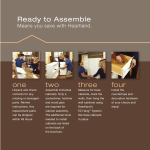
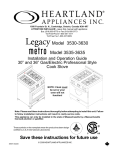
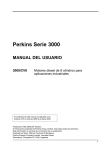
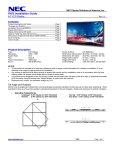

![[U4.52.02] Macro-commande MACRO_MODE_MECA](http://vs1.manualzilla.com/store/data/006360976_1-a4248eaaadfb88c0685de49fb5990c7b-150x150.png)



